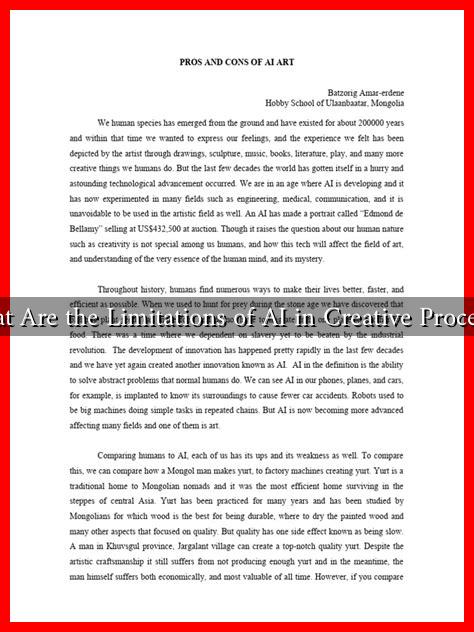-
Table of Contents
What Are the Limitations of AI in Creative Processes
Artificial Intelligence (AI) has made significant strides in various fields, including creative processes such as art, music, writing, and design. While AI tools can generate impressive outputs, they also come with inherent limitations that can affect the quality and authenticity of creative work. This article explores the limitations of AI in creative processes, providing insights into why human creativity remains irreplaceable.
Understanding AI’s Role in Creativity
AI systems, particularly those based on machine learning and deep learning, analyze vast amounts of data to generate content. They can mimic styles, suggest ideas, and even produce original works. However, the essence of creativity involves more than just data processing. Here are some key aspects where AI falls short:
- Lack of Emotional Depth: AI lacks the ability to experience emotions, which are often the driving force behind creative expression. For instance, a piece of music composed by AI may technically be sound, but it may not evoke the same emotional response as a piece created by a human artist.
- Contextual Understanding: AI struggles with understanding context and nuance. For example, a chatbot may generate a poem based on a prompt but may not grasp the cultural or historical significance behind certain themes.
- Originality and Authenticity: AI-generated content often relies on existing works, leading to questions about originality. While AI can create new combinations of existing ideas, it cannot produce truly original concepts in the same way a human can.
Case Studies Highlighting AI Limitations
Several case studies illustrate the limitations of AI in creative processes:
- AI in Visual Arts: The artwork “Edmond de Belamy,” created by the Paris-based art collective Obvious, was generated using a Generative Adversarial Network (GAN). While it sold for $432,500 at auction, critics pointed out that it lacked the depth and intention found in human-created art. The piece was essentially a collage of existing styles rather than a unique expression.
- Music Composition: AI music generators like OpenAI’s MuseNet can compose music in various styles. However, many musicians argue that AI compositions often lack the soul and spontaneity that characterize human-made music. For example, a study by the University of Cambridge found that while AI can replicate musical patterns, it struggles to create pieces that resonate emotionally with listeners.
- Writing and Storytelling: AI writing tools like GPT-3 can produce coherent text, but they often miss the mark on narrative depth and character development. A notable instance is when AI-generated scripts for short films were critiqued for their predictable plots and lack of character arcs, which are essential for engaging storytelling.
The Ethical Implications of AI in Creativity
Beyond technical limitations, the use of AI in creative processes raises ethical concerns:
- Copyright Issues: AI-generated works often raise questions about ownership and copyright. If an AI creates a painting or a song, who owns the rights? This ambiguity can lead to legal disputes and challenges in the creative industry.
- Job Displacement: As AI tools become more prevalent, there is concern about job displacement in creative fields. While AI can assist artists and writers, it may also threaten traditional roles, leading to a potential loss of jobs.
- Quality Control: The reliance on AI for creative processes can lead to a decline in quality. As AI-generated content floods the market, distinguishing between high-quality and low-quality work becomes increasingly challenging.
Conclusion: The Future of AI in Creative Processes
While AI has the potential to enhance creative processes by providing tools and inspiration, its limitations are significant. The lack of emotional depth, contextual understanding, and originality means that AI cannot fully replicate the human creative experience. As we move forward, it is crucial to strike a balance between leveraging AI’s capabilities and preserving the unique qualities of human creativity.
In summary, while AI can assist in generating ideas and content, it cannot replace the emotional and contextual richness that human creators bring to their work. As the creative landscape evolves, understanding these limitations will be essential for artists, writers, and designers who wish to navigate the intersection of technology and creativity effectively.
For further reading on the impact of AI on creativity, you can explore resources from Forbes.

